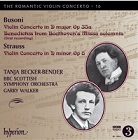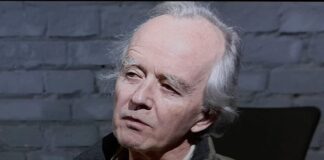
 L’ascolto del piano concerto di Busoni suscita sempre ottime vibrazioni: una massa orchestrale splendidamente organizzata in compartimenti che ci permette di respirare dentro la composizione come in un’aria musicale.
L’ascolto del piano concerto di Busoni suscita sempre ottime vibrazioni: una massa orchestrale splendidamente organizzata in compartimenti che ci permette di respirare dentro la composizione come in un’aria musicale.Per quanto riguarda il Busoni compositore (nettamente il più interessante) le composizioni della fine dell’ottocento lo vedono nettamente uscire stilisticamente dalle grinfie di Brahms e abbracciare, simultaneamente allo stabilirsi dello status virtus di pianista, un proprio stile che è frutto di un allargamento di vedute, di una liofilizzazione della storia musicale (quella in cui era contemporaneo), in previsione di un progetto musicale che usciva dal romanticismo tout court, e si aggrappava a personali sintesi di Bach, Mozart o Beethoven; una tendenza che cercava una diversa esplorazione della tonalità. Pur partendo dal passato, aveva assimilato dentro di sé gli idiomi della modernità, una copertura totale che, a ben vedere, potrebbe essere il prodromo del multi-stilismo della seconda metà del novecento: le sue intuizioni sono intatte, affascinanti, attirano come calamite e soprattutto non portano il peso del tempo.
Di eguali contenuti emotivi è il suo concerto per violino (che segue l’espressività di un altro dei suoi pezzi concertistici più famosi, ossia il concerto per violino e piano n. 2), che non solo mette in evidenza l’importanza della parte solistica (le evoluzioni violinistiche del solista tendono quasi a mettere in secondo piano l’urgenza orchestrale) ma colgono la sua estetica, tutta fondata sulla capacità evocativa della musica e sulla necessità di andare oltre le posizioni raggiunte; forse posizioni teoriche per quegli anni ma che precedevano l’entrata in campo del neoclassicismo francese, delle risonanze, della microtonalità e delle avanguardie del novecento (1).
La pubblicazione n. 16 del Romantic Violin Concerto della Hyperion stabilisce un ulteriore punto di analisi attraverso l’ottima interpretazione della violinista Tanja Becker-Bender con l’orchestra BBC Scottish Symphony condotta da Gerry Walker con l’aggiunta della trascrizione di Benedictus tratto dalla Missa Solemnis di Beethoven, che viene proposta in prima discografica assoluta. Benedictus segnala il differente approccio alla materia della trascrizione, da lui sempre difesa estrenuamente di fronte alla critica, ma certamente procura altre idee all’ascoltatore, diverse da quelle esibite nella propria composizione.
Con Busoni viene allegato il concerto per violino di Strauss. A differenza di quanto dichiarano le note interne, ci fu una caratteristica comune a Strauss e a Busoni, ossia la scrittura svincolata da precedenti troppo intrisi di romanticismo. Anche Strauss fu un traghettore della modernità, una modernità conclamata in maniera esplicita in un momento successivo a questo concerto per violino, il quale pur essendo scritto in uno stadio avanzato del romanticismo (1889), paga le conseguenze della sua omogeneità rispetto agli stilemi del movimento. Scritto in età giovanile, mostra differenze rispetto a Brahms, coinvolgendo in alcuni momenti aspetti del classicismo, con un carattere forte ed angelico che in alcuni momenti ricorda Vieuxtemps. Ma già emergeva un fondamentale status compositivo dell’austriaco riconoscibile nel perfetto ordine di contrapposizione delle entrate tra violino ed orchestra.
Note:
(1) vi riporto questo passo significativo di Busoni, nel suo “Sketch of a new estethic of music”, titolato What Music Expresses.
“….To music, indeed, it is given to set in vibration our human moods: Dread (Leporello), oppression of soul, invigoration, lassitude (Beethoven’s last Quartets), decision (Wotan), hesitation, despondency, encouragement, harshness, tenderness, excitement, tranquillization, the feeling of surprise or expectancy, and still others; likewise the inner echo of external occurrences which is bound up in these moods of the soul. But not the moving cause itself of these spiritual affections;—not the joy over an avoided danger, not the danger itself, or the kind of danger which caused the dread; an emotional state, yes, but not the psychic species of this emotion, such as envy, or jealousy; and it is equally futile to attempt the expression, through music, of moral characteristics (vanity, cleverness), or abstract ideas like truth and justice. Is it possible to imagine how a poor, but contented man could be represented by music? The contentment, the soul-state, can be interpreted by music; but where does the poverty appear, or the important ethic problem stated in the words “poor, but contented”? This is due to the fact that “poor” connotes a phase of terrestrial and social conditions not to be found in the eternal harmony. And Music is a part of the vibrating universe…..”
“I may be allowed to subjoin a few subsidiary reflections:—The greater part of modern theatre music suffers from the mistake of seeking to repeat the scenes passing on the stage, instead of fulfilling its own proper mission of interpreting the soul-states of the persons represented. When the scene presents the illusion of a thunderstorm, this is exhaustively apprehended by the eye. Nevertheless, nearly all composers strive to depict the storm in tones—which is not only a needless and feebler repetition, but likewise a failure to perform their true function. The person on the stage is either psychically influenced by the thunderstorm, or his mood, being absorbed in a train of thought of stronger influence, remains unaffected. The storm is visible and audible without aid from music; it is the invisible and inaudible, the spiritual processes of the personages portrayed, which music should render intelligible….”






